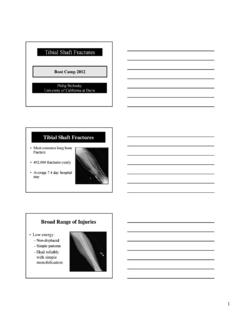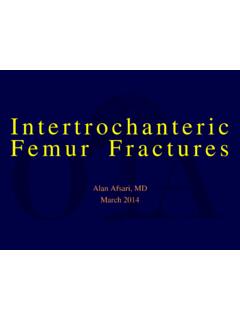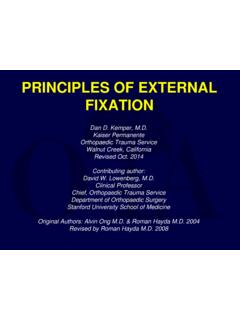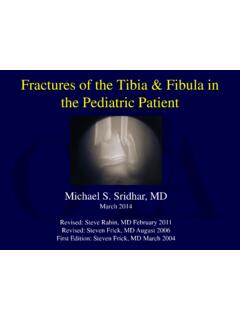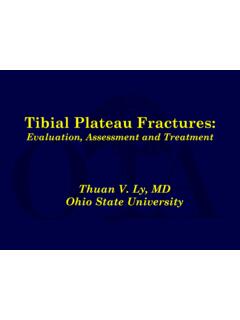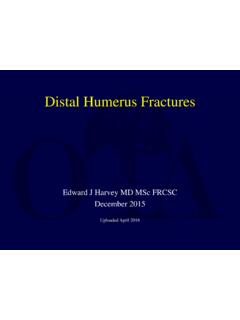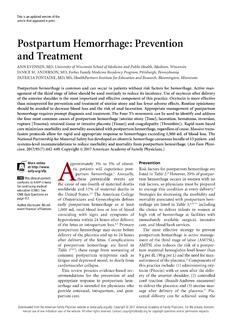Transcription of Fracture Classifications - Orthopaedic Trauma Association ...
1 CoreCurriculumV5 Fracture ClassificationsJaclyn M. Jankowski, DOJersey City Medical Center-RWJB arnabas HealthAll images belong to Jaclyn Jankowski, DO unless otherwise indicatedCoreCurriculumV5 Objectives To understand the need for classification systems To understand the evolution of classification systems To look at the importance of soft tissue injury associated with fracturesCoreCurriculumV5 Why do we have Classifications ? Organize knowledge Transfer information Guide treatment Estimate prognosis Enhance education and communicationCoreCurriculumV5 History of Classification Systems Ancient Egypt The Edwin Smith Papyrus classified injuries as: An ailment which I will treat An ailment with which I will contend An ailment not to be treated CoreCurriculumV5 History of Classification Systems 18thand 19thCentury-Descriptive Classifications based on appearance of limbCCO Dinner Fork Deformity CoreCurriculumV5 History of Classification Systems 20thCentury The advent of radiographs created numerous classification systems Brought about the ability to identify location, amount, and displacement of Fracture lines Not without problems as radiographic views and quality can be inconsistentCoreCurriculumV5 History of Classification Systems The last 40 Years CT has allowed for further understanding and classification of intra-articular fracturesCoreCurriculumV5 History of Classification Systems Believe it or not there s more to consider than just bones!
2 X-rays or CT alone can underestimate the severity of the overall injury and don t consider patient status=CoreCurriculumV5 What makes a good classification? Inter-observer Reliability Do different physicians agree on the classification of a particular Fracture ? Intra-observer Reproducibility For a given Fracture , does the same physician classify it the same way at different times?CoreCurriculumV5 Types of Classification Systems Fracture -Specific Universal Soft Tissue Injury Associated with FractureCoreCurriculumV5 Examples of Fracture -Specific Descriptive Classifications Garden guides management/surgical plan Neer assists describing Fracture for communication Schatzker can predict associated injuries and prognosis Lauge-Hansen provides insight into mechanism Sanders- an example of CT-based classificationCoreCurriculumV5 Garden ClassificationI Valgus impacted or incompleteII CompleteNon-displacedIII CompletePartial displacementIV CompleteFull displacement** Portends risk of AVN and Nonunion**IIIIIIIVNon-DisplacedDisplaced Images courtesy of Frank Liporace.
3 MDCoreCurriculumV5 Garden ClassificationPros-Determining displaced vs nondisplaced is critical for dictating management-Classification has highest inter-and intra- observer reliability when compared to Pauwel s and AO classificationsCons-Poor interobserver reliability between Types I and II-Classification based on AP radiograph only can underestimate degree of displacementKazley JM, Banerjee S, Abousayed MM, Rosenbaum AJ. (2018). Classifications in brief: Garden classification of femoral neck fractures. Clin Orthop Relat Res. 476 Classification Based on anatomic segments of the proximal humerus Considered to be a part if arbitrarily displaced 1 cm or angulated 45o Classification has good intraobserver reliability, but only moderate interobserver reliability, though still useful for communication purposesDirschl DR. In: Rockwood and Green s Fractures in Court-Brown CM, Heckman JD, McQueen MM, Ricci WM, Tornetta III P, eds.
4 Wolters Kluwer Health; J, Adler LM, Blank JE, Dlasey RM, Williams GR, Iannotti JP. (1996). Evaluation of the Neer system of classification of proximal humerus fractures with computerized tomographic scans and plain radiographs. Journal of Bone and Joint Surgery, 78-A(9): 1371-1375. CoreCurriculumV5 Schatzker ClassificationI: Lateral SplitII: Split DepressionIII: Lateral DepressionCoreCurriculumV5 Schatzker ClassificationIV: Medial PlateauV: BicondylarVI: Metaphyseal-Diaphyseal DissociationCoreCurriculumV5 Study to compare the inter-observer reliability and intra-observer reproducibility of the Schatzker, AO, and Hohl and Moore Classifications of tibial plateau fractures Four observers at different points in their careers classified 50 tibial plateau fractures Schatzker showed superior inter-observer reliability and intra-observer reproducibility compared to AO and Hohl and Moore --> though still not perfect Schatzker ClassificationCoreCurriculumV5 Schatzker Classification Associated Injuries By Fracture Type Schatzker II Lateral meniscal tears Schatzker IV medial meniscal tears, ACL injury, vascular injury Schatzker VI ACL injury, compartment syndromeBennet WF and Browner B.
5 (1994). Tibial plateau fractures: A study of associated soft tissue injuries. J Orthop Trauma . 8(3) ClassificationSupination External RotationBased on position of ankle and direction of force applied at time of injurySupination AdductionCoreCurriculumV5 Lauge-Hansen ClassificationBased on position of ankle and direction of force applied at time of injuryPronation AbductionPronation External RotationCoreCurriculumV5 Lauge-Hansen ClassificationPros-Provides understanding of mechanism for rotational ankle fractures-Enables interprofessional communication for rotational ankle fracturesCons-Found to have the lowest interobserver reliability when compared to the AO and Danis-Weber Classifications -Classification cannot be used for non-rotational ankle fracturesLopes da Fonseca L, Nunes IG, Nogueira RR, Martins GEV, Mesencio AC, Kobata SI. (2018). Reproducibility of the Lauge-Hansen, Danis-Weber, and AO Classifications for ankle fractures.
6 Rev Bras Ortop. 53(1) Classification CT-based classification looking at the widest part of the calcaneus: Number articular Fracture fragments Location of fragments Compare to x-ray-based Essex-Lopresti it provides increased insight: Fracture pattern Pre-op planning PrognosisCoreCurriculumV5 Sanders Classification Type I:all fractures with <2mm displacement Type II:two-part fractures of the posterior facet Type III:three-part fractures of the posterior facet Type IV:highly comminuted Fracture with four or more Fracture linesDirschl DR. In: Rockwood and Green s Fractures in Court-Brown CM, Heckman JD, McQueen MM, Ricci WM, Tornetta III P, eds. Wolters Kluwer Health; Cross-sectional study of 100 pre-op CT scans of patients with intra-articular calcaneus fractures operated on by a single surgeon Researchers reported: Good to excellent intra-observer reproducibility Moderate inter-observer reliability (which was better than what was previously reported in the literature).
7 Validity was reported to be fair Sanders ClassificationCoreCurriculumV5 Universal Classification SystemCoreCurriculumV5 OTA/AO Classification Alphanumeric classification that can be applied throughout the skeleton, based on Fracture location and morphology Created in the 1960 s and multiply updated to include Classifications of the pelvis and acetabulumCoreCurriculumV5 OTA/AO Classification Fracture Location Which bone? Each bone is assigned a specific numberCoreCurriculumV5 OTA/AO Classification Fracture Location Which part of the bone? 1. Proximal end segment 2. Diaphyseal segment 3. Distal end segment123 CoreCurriculumV5 OTA/AO Classification Fracture Morphology Diaphyseal segment Type A: Simple fractures spiral, oblique, transverse Type B: Wedge fractures spiral, bending, fragmented Type C: Multifragmentary fractures spiral wedge, segmented, irregularCoreCurriculumV5 OTA/AO Classification Fracture Morphology End segment Type A: Extra-articular Type B: Partial articular Type C: Complete articularCoreCurriculumV5 OTA/AO Classification Now have additional Subgrouping Goal of Subgrouping: to increase the precision of the classification Subgroups differ amongst each boneCoreCurriculumV5 OTA / AO Classification Subgrouping Complex and value not fully known (Example: Distal Femur)CoreCurriculumV5 But what about the soft tissues?
8 CoreCurriculumV5 Soft Tissue-Based Classifications Oesterne and Tscherne Classification Gustilo- anderson Classification OTA Open Fracture ClassificationCoreCurriculumV5 Oesterne and Tscherne Classification Classification of soft tissue damage in the setting of a closed fractureGradeSoft Tissue InjuryBony InjuryGrade 0 Minimal soft tissue damageIndirect injury to limbSimple Fracture pattern Ex: low energy spiral fracturesGrade 1 Superficial abrasion/contusionMild Fracture patternEx: rotational ankle Fracture -dislocationsGrade 2 Deep abrasion with skin or muscle contusionDirect Trauma to limbSevere Fracture patternEx: segmental fracturesGrade 3 Extensive skin contusion or crushSevere underlying muscle damageSubcutaneous avulsionPossible compartment syndromeSevere Fracture patternIbrahim DA, Swenson A, Sassoon A, Fernando ND. (2017). Classifications in brief: The Tscherne Classification of soft tissue injury.
9 Clin Orthop Relat Classification Type I: wound 1 cm, minimal contamination or muscle damage Type II: wound 1-10 cm, moderate soft tissue injury Type IIIA: wound usually >10 cm, high energy, extensive soft-tissue damage, contaminated, but with adequate tissue for flapcoverage Type IIIB: extensive periosteal stripping, woundrequires soft tissue coverage (rotational or free flap) Type IIIC: vascular injury requiringvascular repair,regardless of degree of soft tissue injury**Appropriate classification can only be made intraoperatively**Kim PH and Leopold SS. (2012). Gustilo- anderson classification. Clin Orthop Relat Res. 470 Classification of Open Fractures Assigns severity to five essential factors for treatmentEssential be be muscle in area/no appreciable of muscle; intact function, localized muscle, loss of injury without injury with or in bone or deep tissuesBone missing or devascularized, but still contact present between proximal and distal bone lossOrthopaedic Trauma Association : Open Fracture Study Group.
10 (2010). A new classification scheme for open fractures. J Orthop (8): Classification Systems OTA Open Fracture Classification System appears superior to Gustillo- anderson Classification System in both reliability and validity 86% overall interobserver agreement vs 60% for G-A JOT: 2013 vol 27; pp379-384 Interobserver RELIABILITYis different than VALIDITY If surgeons agree on a measurement pre-operatively ( reliability ), that may not prove to be accurate intra-operatively ( validity ) JAAOS: 2002 vol 10; pp290-297 CoreCurriculumV5 Prospective study to determine if descriptive Classifications of diaphyseal tibia fractures are predictive of prognosis Compared AO, Gustilo- anderson , Tscherne, and Winquist-Hansen Classifications and looked at union, need for future surgery, and subsequent infection Found that the Tscherne Classification was most predictive of final outcomeUse of Soft Tissue and Open Fracture ClassificationsCoreCurriculumV5 Summary Classifications are essential for communication, education, treatment guidelines, and as a prognostic tool As imaging technology has advanced so have our Fracture Classifications The soft tissue can t be ignored and classification systems taking the soft tissue envelope into consideration are essential for creating a complete prognostic pictureCoreCurriculumV5 References Bennet WF and Browner B.


